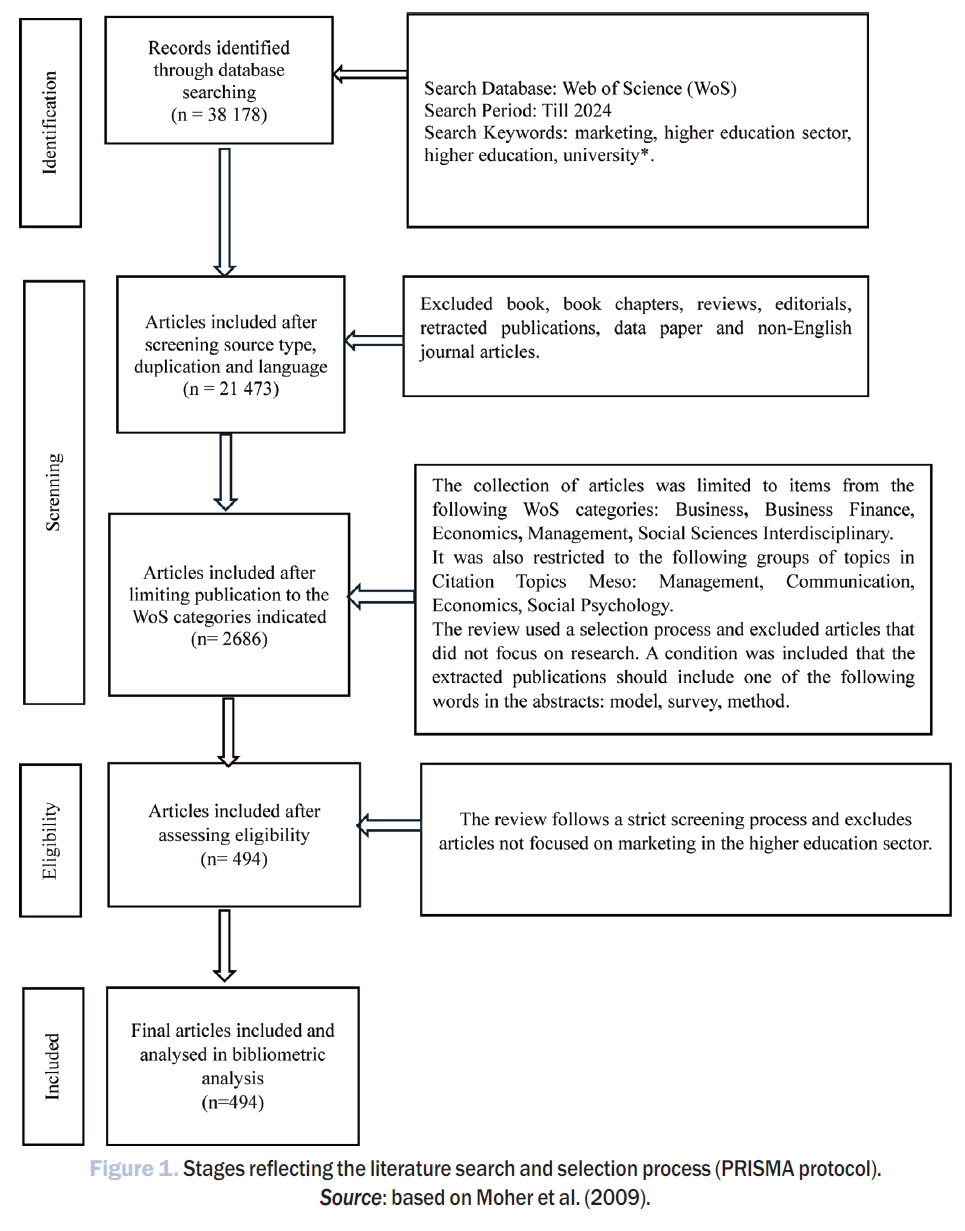- eISSN 2353-8414
- Phone.: +48 22 846 00 11 ext. 249
- E-mail: minib@ilot.lukasiewicz.gov.pl
Marketing of higher education institutions: Research themes and their shifting relevance over time
Krzysztof Błoński1, Jolanta Witek2
1 University of Szczecin, 22a Papieża Jana Pawła II Ave., 70-453 Szczecin, Poland
2 Jacob of Paradies University, Chopina St. 52/Building 7, 66-400 Gorzów Wielkopolski, Poland
1 E-mail: krzysztof.blonski@usz.edu.pl
ORCID: 0000-0002-1713-625X
2 E-mail: jwitek@ajp.edu.pl
ORCID: 0000-0002-8120-6494
DOI: 10.2478/minib-2025-0005
Abstract:
This article explores the role of Facebook posts as a tool for building consumer engagement with the travel agency community. A quantitative content analysis of the posts of Poland’s largest travel agencies reveals that while promotional posts received the most likes, interactive posts generated greater engagement in the form of more comments. Smaller agencies in some cases outperformed larger competitors in terms of comment frequency, highlighting the importance of content strategy. Analysis of the sentiment expressed in the comments showed the prevalence of mostly positive or neutral comments, with companies effectively managing negative comments. The findings suggest that interactive posts foster deeper consumer engagement, highlighting the need for travel agencies to diversify their content strategy and actively engage their audiences. The study recommends that travel agencies strive to optimize social media engagement by balancing promotional posts with interactive posts that encourage discussion, such as questions, surveys and other posts not related to advertising the products on offer. Moreover, analyzing sentiment in such comments can help refine a brand’s communication strategy, improving consumer relationships and brand perception.
MINIB, 2025, Vol. 55, Issue 1
DOI: 10.2478/minib-2025-0005
P. 69-89
Published March 19, 2025

Marketing of higher education institutions: Research themes and their shifting relevance over time
1. Introduction
The evolving perception of the role of marketing at universities is a natural consequence of the expanding higher education market at the turn of the century and the attendant challenges that have arisen. As universities operate in an increasingly dynamic environment, they must adopt deliberate marketing strategies to remain competitive and relevant. Within the education system, universities contribute to societal and economic development by providing education in specific fields of knowledge, conducting scientific research, as well as developing and promoting national culture and technological progress.
Changes in the higher education environment – driven by unfavourable demographic shifts, changes in the ways in which universities are financed, globalisation processes, and rapid technological and informational advancements – have necessitated the adoption of a marketing-oriented approach at universities, modelled on those seen in other industries. These changes entail not only a need to adapt the instruments used to emerging challenges, but also a shift in the perception of the role of marketing in higher education.
Marketing in higher education is a specialized branch of service marketing that has evolved alongside increasing competition and the commercialisation of education. Marketing strategies allow universities to stand out in a competitive market, attract students and build a strong brand, which is essential for their development and survival. Universities, like businesses, must present themselves effectively to their target audience, which primarily consists of students, but also includes employers and the general public.
Marketing in this context includes image and reputation management as well as effective communication, focusing on the intangible aspects of the university’s offerings, such as quality of its teaching, its reputation and the student experience. Much like other service organisations, universities must build relationships with their customers, i.e. students and other stakeholders, and strive to tailor their activities to their expectations. Effective marketing of educational services crucially involves managing the perceptions of service quality, communicating the value of the programmes offered, and maintaining consistency in branding and messaging. Furthermore, universities must continuously monitor and refine their marketing strategies in response to shifting market demands and audience expectations, while taking into account the specific needs and motivations of students and building lasting relationships with graduates.
Modern marketing efforts in higher education are increasingly taking place in the digital sphere, where universities use websites and social media to communicate with potential students. By maintaining an active online presence and utilizing a variety of communication tools, universities strive to build lasting relationships with both current and future students.
The unique nature of marketing in higher education stems from its dual purpose: attracting students while upholding the university’s broader mission of education, research, and human capital development. Marketing strategies must be coherent with the institution’s values and cater to multiple audiences. Effective marketing activities should therefore focus on:
- building a strong university brand that is recognisable and valued in the market,
- market segmentation, with the offerings tailored to the needs of different groups of students,
- using digital tools to communicate and build relationships with students,
- constantly monitoring and adjusting strategies based on market trends and audience expectations,
- striving for student satisfaction and loyalty.
Universities that successfully combine marketing with their educational mission can achieve lasting success in the increasingly competitive environment.
The purpose of this study is to analyse evolving research trends on the role of marketing in higher education. This analysis will be supplemented with insights into the relevance of key publications, authors, and sources within the field. The study will be based on bibliometric analysis of metadata from relevant publications indexed in the Web of Science.
2. Literature review
Different types of reviews of the literature on the marketing issues addressed in higher education, i.e. systematic literature reviews, bibliometric analyses and meta-analyses, typically select one topic/issue from the given research area and qualitatively or quantitatively review the existing publications on that topic. Examples of this approach include review studies on social media use (Pawar, 2024), conceptualising market orientation (Dwyer, 2024), reputation and its management (Amado et al., 2022; Sun & Lim, 2023; Faraoni et al., 2023), service quality and student satisfaction (Weerasinghe & Fernando, 2017; Onditi & Wechuli, 2017; Santini et al., 2017) lecturer satisfaction (Hoang, 2023), university brands (Yaping et al., 2023; Le et al., 2023), digital marketing (Jain & Rao, 2024) and university social responsibility (Fauzi et al., 2023).
In contrast, some scholars adopt a broader approach when defining the scope of their reviews. Notable examples include the works of Hemsley-Brown and Oplatka (2006, 2011) and Rabenu and Shkoler (2022). Hemsley-Brown and Oplatka carried out a systematic literature review of marketing in higher education twice: the first review covered the period 1992–2004, while the second (which can be seen as a supplement/extension/update) covered the period 2005–2018. Their research identified several key phases in the evolution of marketing within higher education. Initially, in the 1980s and 1990s, marketing in education was treated as an adaptation of practices from the business sector, dominated by theoretical-normative approaches and handbooks on marketing techniques. Students were seen as a university’s “product,” employers as its customers. In the 1990s, a narrower view of marketing communications emerged, where the decision-making process of students and the content of print publications were analysed. Over time, it was understood that higher education was better understood as a service rather than a product, which led to the implementation of service marketing theory. During this period, attention began to be paid to building relationships with customers and using business models, especially those developed by Kotler.
After 2006, the increasing commercialisation of higher education worldwide prompted universities to adopt free-market practices and a more professional approach to marketing. At the same time, the importance of marketing communication, including online marketing and social media, increased. Authors began to focus on studying the effectiveness of these tools, their impact on the university’s image and ways of engaging audiences. Branding became a key area of research and universities began to consciously build their brands. In addition, research covered the effectiveness of marketing strategies, recruitment, alumni relations and donations. As a result, five main research topics have been identified: commercialisation, marketing communication, brand building, marketing strategy, and recruitment, alumni and donations. An important measure of an author’s influence within these research areas is the citation frequency of their publications.
Additionally, it is worth noting that certain books – although they are excluded from the bibliometric analyses that follow – have been extensively cited in academic discussions on marketing in higher education. These include Krip (2003), Molesworth et al. (2011), Maringe and Gibbs (2008), and Brown and Carraso (2013). From the Polish market, relevant books on similar topics include Drapińska (2011), Dziewianowska (2018), Hall (2011, 2022) and Leja (2011).
3. Research methodology
The general workflow for scientific mapping analysis involves a number of key steps (Börner et al. 2003; Cobo et al. 2011a): data search, preprocessing, network extraction, normalisation, mapping, analysis and visualisation. The final stage of this process involves interpreting the results obtained and drawing conclusions from them.
The objectives of the present bibliometric study are as follows:
- to identify which journals, authors and papers are most frequently cited in the research area “marketing in higher education”,
- to identify the journals, authors that have the greatest impact on research in the research area,
- to identify key research topics in the area under study and track the changes that have taken place over time (i.e. from the first identified publication on the given topic to the present day).
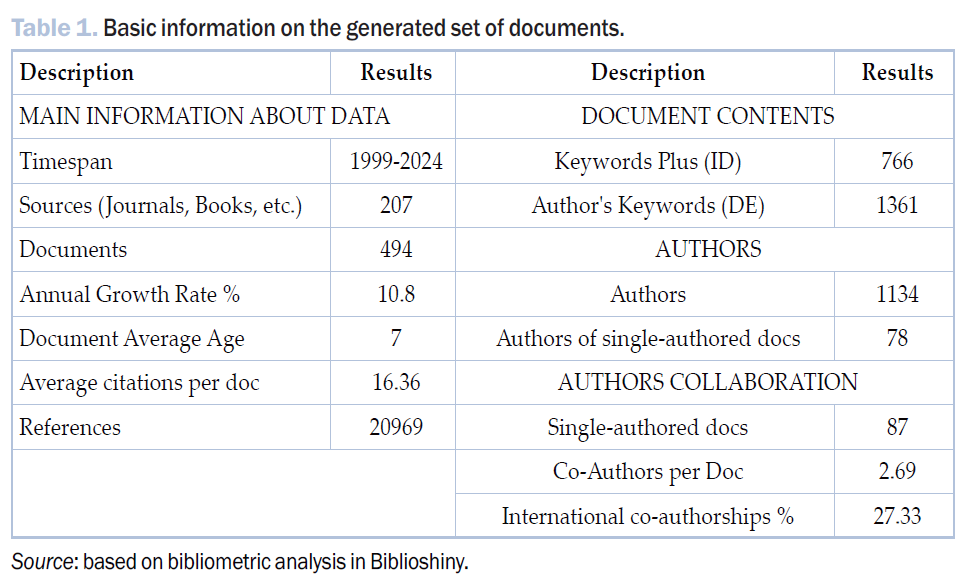
There are several possible online bibliographic databases for data retrieval. The most important of these are Web of Science, Scopus or Google Scholar. These databases vary in terms of their coverage of specific scientific disciplines and journals, each with its own advantages and limitations, often discipline-specific (Bar-Ilan, 2010; Falagas et al., 2008).
For this study, the Web of Science (WoS) database was selected as the primary source of publications for a scientific mapping analysis. However, scientific map analysis should not be applied directly to data extracted from bibliographic sources, as these may contain errors. Therefore, a pre-processing step should be applied to improve the quality of the data. Various preprocessing methods can be used, including those that detect duplicate and misspelled elements, time-sharing and data reduction. The details of this process are shown in Figure 1.
The metadata of the 494 articles so selected was transferred to Biblioshiny software (Aria, Cuccurullo, 2017) to prepare for analysis. Subsequently, the completeness of the individual fields in the database was assessed to evaluate the quality of the data obtained. In all fields, i.e. author(s), publication title, and keywords, the proportion of missing responses is either zero or negligibly low. The characteristics of the resulting set of publications are shown in Table 1.
Citation analysis was used to achieve the stated objectives1 and identify research trends through text analysis. Citation analysis was carried out across the entire timeline from the first identified publication on a given topic in the database to October 2024 (when the present analysis was carried out). To track research trends over time, the study divided the dataset into four sub-periods (1999–2009, 2010–2014, 2015–2019, 2020–2024)2. The characteristics of the resulting subsets of publications are shown in Table 2.
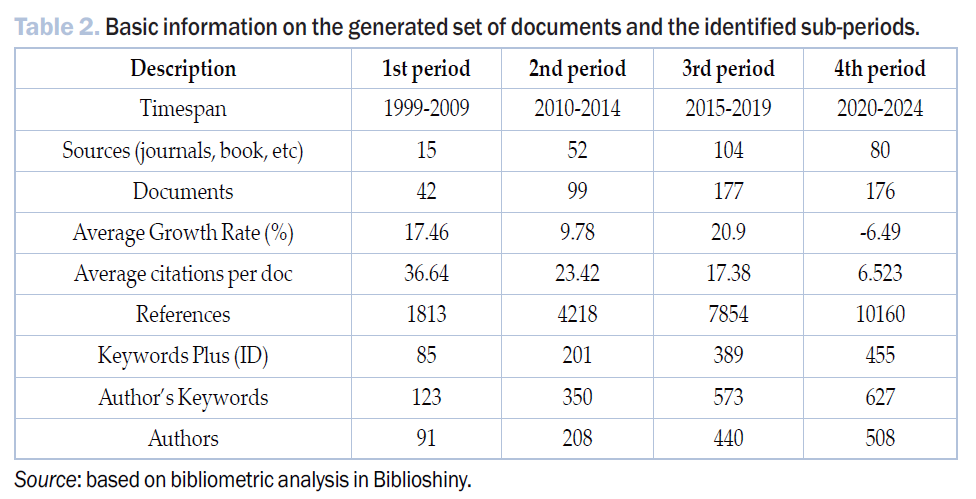
In parallel, we manually merged author keywords of similar relevance. This is a necessary step to improve the quality of the bibliometric and thematic analysis. Next, a science mapping analysis was carried out using Biblioshiny software to analyse the thematic structure and evolution of the research themes.
The themes obtained from the science mapping analysis are represented by a strategy diagram and a thematic network structure. Biblioshiny automatically calculates centrality (x-axis) and density (y-axis) values for each topic, and these are usually presented in a four-field, two-dimensional diagram. In this case, the centrality values reflect the extent of interactions between clusters and the strength of relationships between them. Results are presented in the dieagram as follows (Cobo et al. 2011b):
- Themes in the upper right quadrant (Motor Themes) are both well developed and important for structuring the research field. These are known as Motor Themes of Specialisation, given that they show strong centrality and high density. The placement of themes in this quadrant suggests that they are externally linked to concepts applicable to other themes that are conceptually closely related.
- Themes in the upper left quadrant (Niche Themes) have well-developed internal linkages but insignificant external linkages and are therefore only marginally relevant to the field. These themes are highly specialised and peripheral in nature.
- Themes in the bottom left quadrant (Emerging or Declining Themes) are both underdeveloped and marginal. Themes in this quadrant are low in density and low in centrality, representing mainly emerging or declining themes.
- Themes in the lower right quadrant (Basic Themes) are important to the research field but are not developed. This quadrant therefore contains cross-cutting and general basic themes.
4. Relevance of publications, authors and marketing publications in higher education
The earliest publication in the generated set of publications containing research results on marketing in university activities dates back to 1999. For the next five years, research in this area received little attention from researchers. However, there was a clear increase in publications since the mid-2000s. For instance, there were 62 publications in 2010, 115 in 2013, and 352 in 2020. This growth likely reflects the cumulative development of new ideas built upon previous scientific achievements.
Figure 2 shows the changes in the number of publications on marketing in higher education activities between 1999 and 2024. An analysis of the average citations per year can complement the resulting picture. The graph with average citations per year identifies several points in time – such as 2007 and 2009 – with a higher number of citations.3

When the results from Figures 1 and 2 are juxtaposed with the data in Tables 1 and 2, several basic conclusions emerge. The number of publications reporting research in the field of marketing in higher education has been steadily increasing across the defined periods. Similarly, the number of citations per publication and the pool of contributing authors are both on the rise.
In addition, relevant publication outlets can be identified by considering both the number of articles published and the corresponding bibliometric indices. For the research area analysed, the three journals publishing the most articles are: Journal of Marketing for Higher Education, International Journal of Educational Management, and Asia Pacific Journal of Marketing and Logistics. A detailed overview is presented in Table 3.
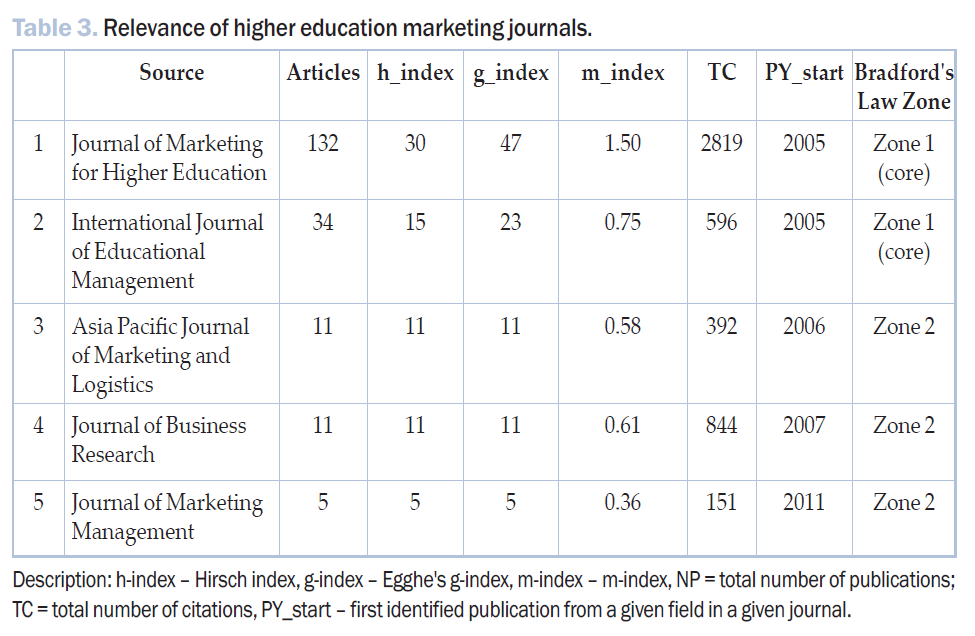
The author with the largest number of publications in the area under analysis is Chris Chapleo with 6 publications (published independently as author or co-author, which means that his “fractionalized authorship” score is 4.03), followed by Tamer Elsharnouby, who also published 6 articles (albeit with a lower fractionalized authorship score, i.e. 3.5), and Emmanuel Mogaji with 5 publications (fractionalized authorship 2.17). The above list can be supplemented by the bibliometric index values (i.e. h-index, g-index, m-index) determined for each author. Details are provided in Table 4.
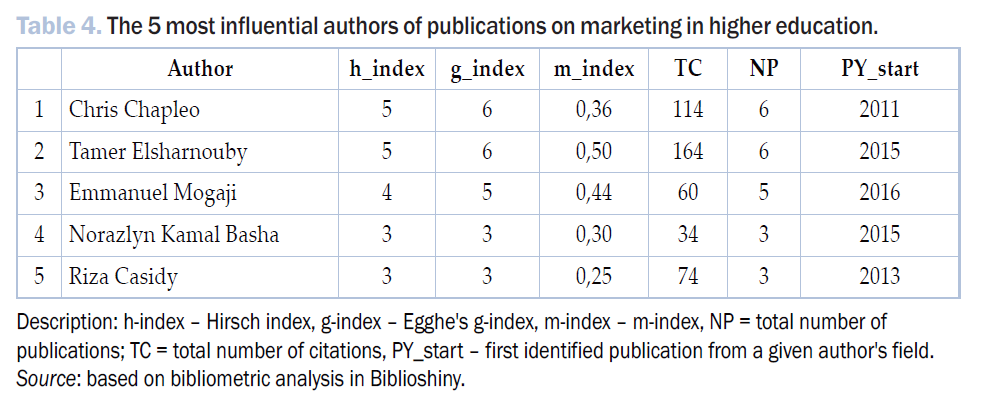
A second important measure of a given author’s contribution to the advancement of a particular field of research is the number of citations of his or her publications in that field. Among authors publishing on marketing in higher education, the most frequently cited are Jane Hemsley-Brown (with 48 citations), Adam Peruta, Alison B. Shields (43 citations each) and Shivonne Goonawardana (42 citations).
A ranking of the most cited papers can be constructed based on citations from the entire database (so-called global citations) or based on citations from items in the generated set of documents (so-called local citations). There may be differences between the two lists (i.e. global citations may be more numerous than local citations). Since this study focuses on research trends in higher education marketing, the local citation metric was prioritized. Table 5 summarizes the top 10 most cited publications in this field.
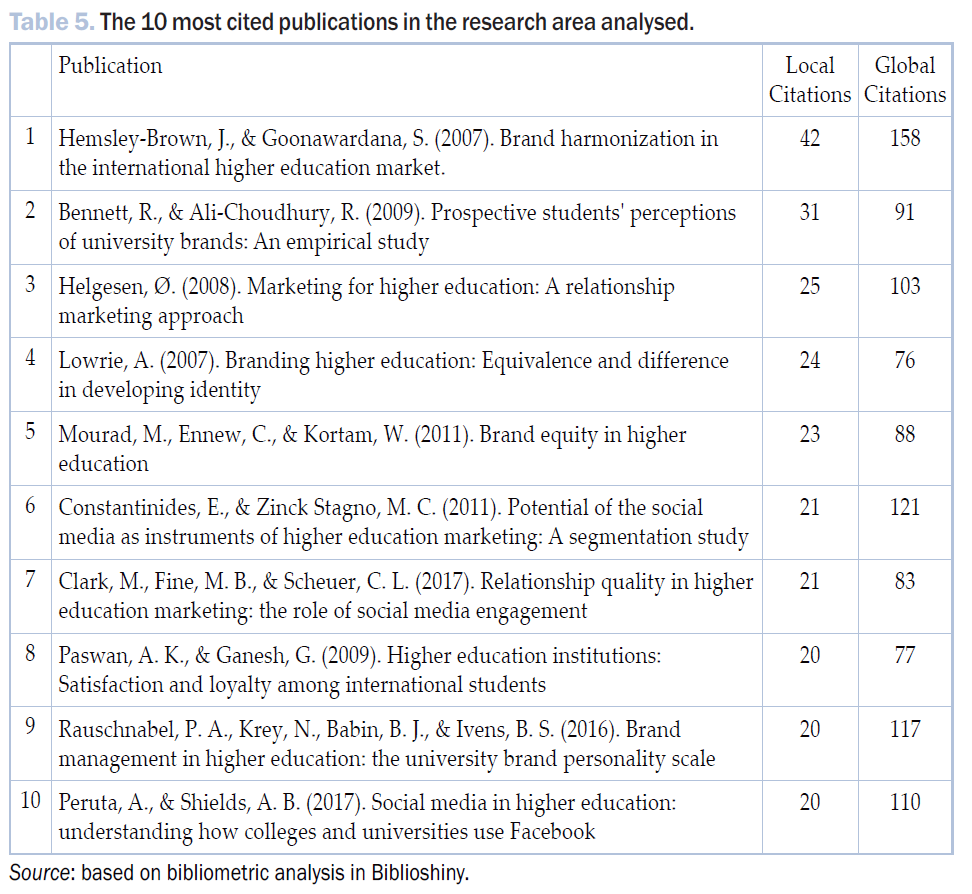
In first place is an article by Hemsley-Brown, J. and Goonawardana, S. from 2007, entitled: Brand harmonisation in the international higher education market. This is followed by an article by Bennett, R and Ali-Choudhury, R. from 2009, entitled Prospective students’ perceptions of university brands: An empirical study. The third place is occupied by an article published by Helgesen, Ø. in 2008 entitled Marketing for higher education: A relationship marketing approach. A summary of the first 10 publications with citation data is provided in Table 5. A closer look at this list reveals that the dominant research themes in the most influential works are branding and social media in higher education marketing. These articles represent key foundational works in the field and could be considered part of a ‘must-read’ list for researchers and authors exploring this topic.
5. Research topics in marketing in higher education, their relevance and variability
Next, the research topics addressed in each publication were identified based on the author-assigned keywords. There are 1,361 author keywords in the generated set of publications, as opposed to 766 keywords assigned by algorithms in the Web of Science database (Keywords Plus). The larger number of author keywords should, we anticipated, ensure a greater diversity of keywords, which should provide the opportunity to identify research topics more precisely.
Once the resulting set of keywords was organized and refined, several research topics in this area could be tentatively identified.4 Notably, themes previously identified from publication titles – such as branding and brand image and the use of social media – are reinforced. Additionally, new recurring themes have been identified, including: student satisfaction and loyalty, service quality, marketing orientation. A detailed summary of the 15 most frequently occurring keywords is provided in Table 6.
The research topics presented in Table 6 relate to the full time period from 1999 to 2024. For more granularity in identifying researchers’ interest in particular topics in different periods, the topics were analysed for the four sub-periods (1999–2009, 2010–2014, 2015–2019, 2020–2024). The results are presented in Table 7.
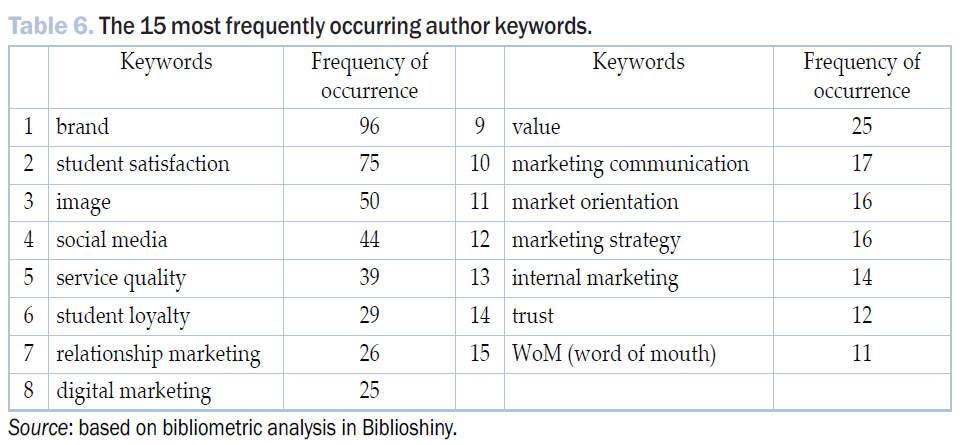
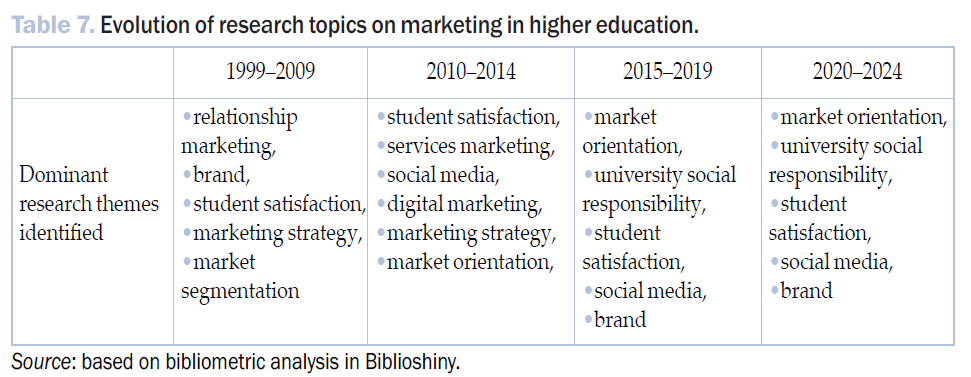
The next step sought to determine the relevance of the identified research themes, based on four-field thematic maps5 generated for each time period. The thematic map for the first period, i.e. 1999–2009 (Figure 3), shows a lack of motor themes, but themes in the other three areas can be identified. The individual thematic clusters are rather self-contained groups, not connected to each other.
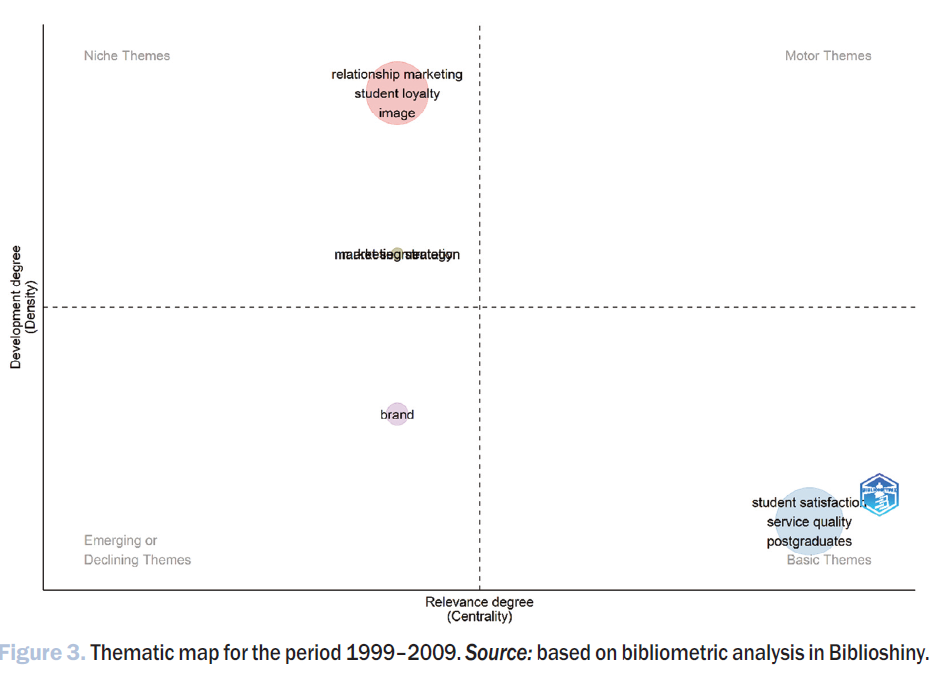
In the map for 2010–2014, research topics appear in all fields (Figure 4). A greater thematic differentiation of the research carried out is becoming apparent, and links between the different clusters of the network are also beginning to emerge. Some of the themes (e.g. student satisfaction) do not change their position (i.e. they are still core themes), while others change their position (e.g. student loyalty stops being a niche theme and starts being a core theme). New niche themes are emerging, and these include internal marketing and job satisfaction.
The map for the third period (2015–2019) reveals further changes in terms of the relevance of research topics (Figure 5). The themes of brand and image have become driving themes. A similar position as in earlier periods is occupied by student satisfaction. New themes concerning values or curriculum (as a product/service concept) are emerging. A change in relevance can also be observed for topics regarding marketing orientation (shifting from the core topics area to niche topics). Research topics relating to the use of social media are now in the core topics section (in the previous period they were classified as a motor topic).
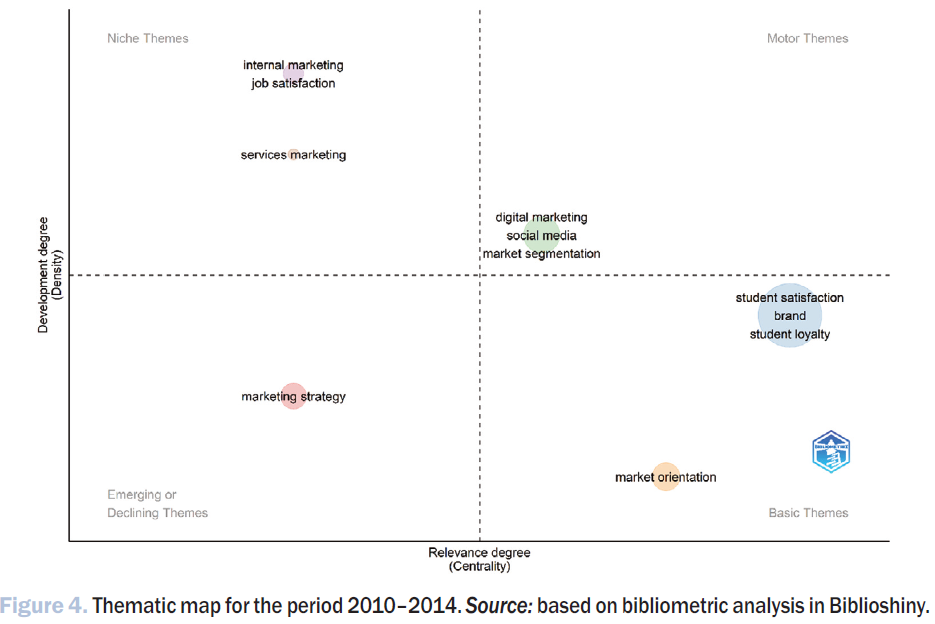
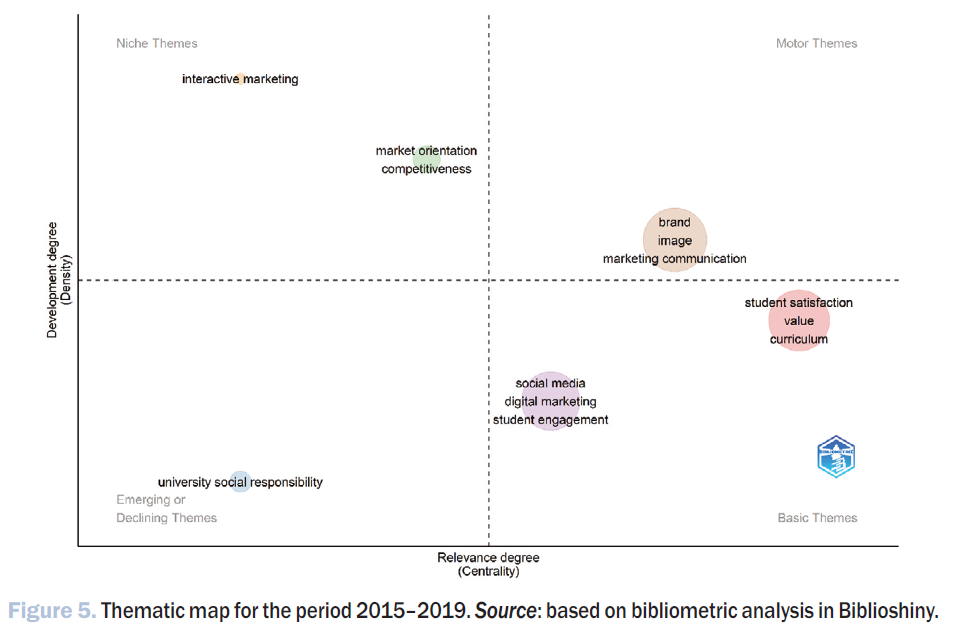
The final period studied, 2020–2024 (Figure 6), reveals the emergence of further research topics, e.g. related to international students, sustainability issues and e-learning. Research on branding, image and student satisfaction continues, while digital marketing remains a core theme.
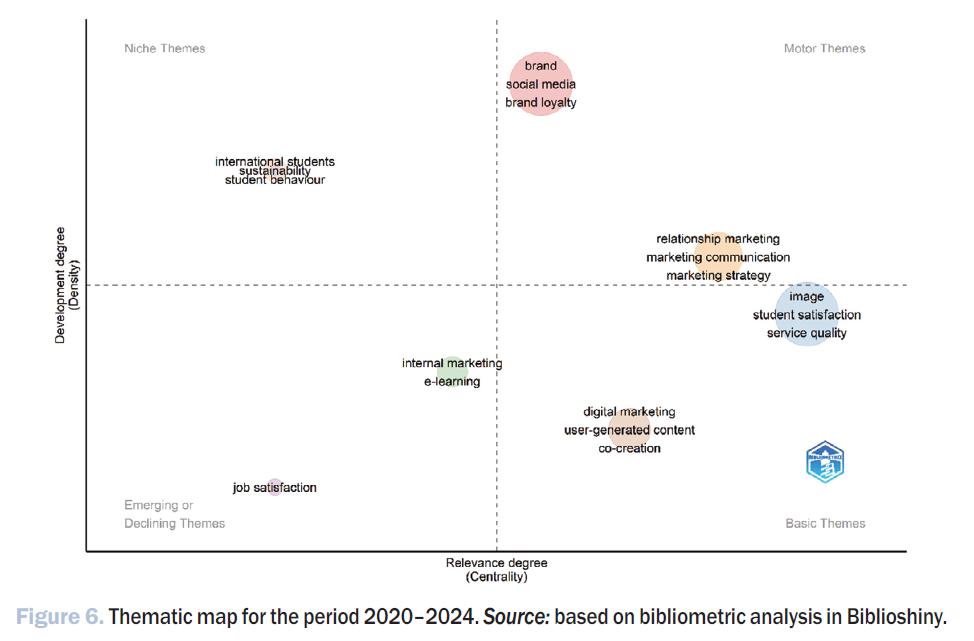
6. Disscussion and conclusions
The research objectives outlined in the methodology section led to the use of citation analysis, which focused on publication and author data while omitting aspects such as author affiliations and country of origin. In identifying research topics, only author-assigned keywords were considered, while Keywords Plus was excluded. Despite these limitations, the information gathered (Table 8) successfully addresses the stated research objectives.
In the initial phase, the application of marketing and its principles was often fragmented and poorly coordinated and integrated. Nowadays, however, the discussion is no longer about the validity of applying the concepts of marketing to higher education institutions, but rather about how to properly adapt marketing tools to the specifics of the educational market and what opportunities marketing offers such institutions.
For example, in view of the increasing surplus of university places universities in many countries are seeing in relation to the number of applicants, entailing intensified national and international competition, the importance of the university’s brand, currently one of the pillars of university positioning, is certainly on the rise. Thus, having a good brand, becoming synonymous with the prestige of a university, can support market expansion and serve as an indicator of the university’s value and quality.
The growing number of publications studying the use of marketing in higher education suggests that this research area will continue to develop, albeit at a gradual pace. Rather than experiencing rapid expansion, the field is likely to see steady contributions from individual researchers. The journals cited in these publications also indicate a transfer of knowledge from broader marketing research into the field of higher education marketing.
To address the research objectives outlined in the methodology section above, we applied citation analysis, focused solely on publication and author data. Certain aspects, such as author affiliations and information about their country of origin, were omitted. Similarly, in the identification of research topics, author-provided keywords were utilized, with Keywords Plus excluded. Despite these limitations, the information gathered (Table 8) successfully addresses the stated research objectives.
The first stated objective was to identify the most frequently cited journals, authors and papers in the field of “Marketing in Higher Education”. The most cited publication in the given set of publications is Hemsley-Brown and Goonawardana (2007), followed by Bennett and Ali-Choudhury (2009) and Helgesen (2008). The indicated articles form part of a recommended reading list on the use of marketing in higher education. The authors of the publications with the highest number of citations are: Jane Hemsley-Brown (48 citations), Adam Peruta and Alison B. Shields (43 citations each). In contrast, the most cited journals in this area are: Journal of Marketing for Higher Education (1212 citations), Journal of Marketing (956 citations) and Journal of Business Research (800 citations). These journals reflect the main sources of knowledge generation and transfer in higher education marketing research.
The second objective involved identifying the journals and authors with the greatest impact on research in this area. Four such journals were identified: Journal of Marketing for Higher Education, International Journal of Educational Management, Asia Pacific Journal of Marketing and Logistics and Journal of Business Research. The most influential authors include Chris Chapleo, Tamer Elsharnouby and Emmanuel Mogaji.
The third objective concerted with the identification of the research themes pursued in each time frame. By dividing the dataset into four sub-periods, the study revealed thematic shifts in higher education marketing research. The comparison between early and later periods shows an increasing diversity of topics. The results dovetail with findings from other literature reviews, although differences may arise due to broader search criteria used in systematic reviews. While systematic literature reviews can include multiple databases, bibliometric analyses typically rely on one of the two largest scientific publication databases—Web of Science or Scopus.
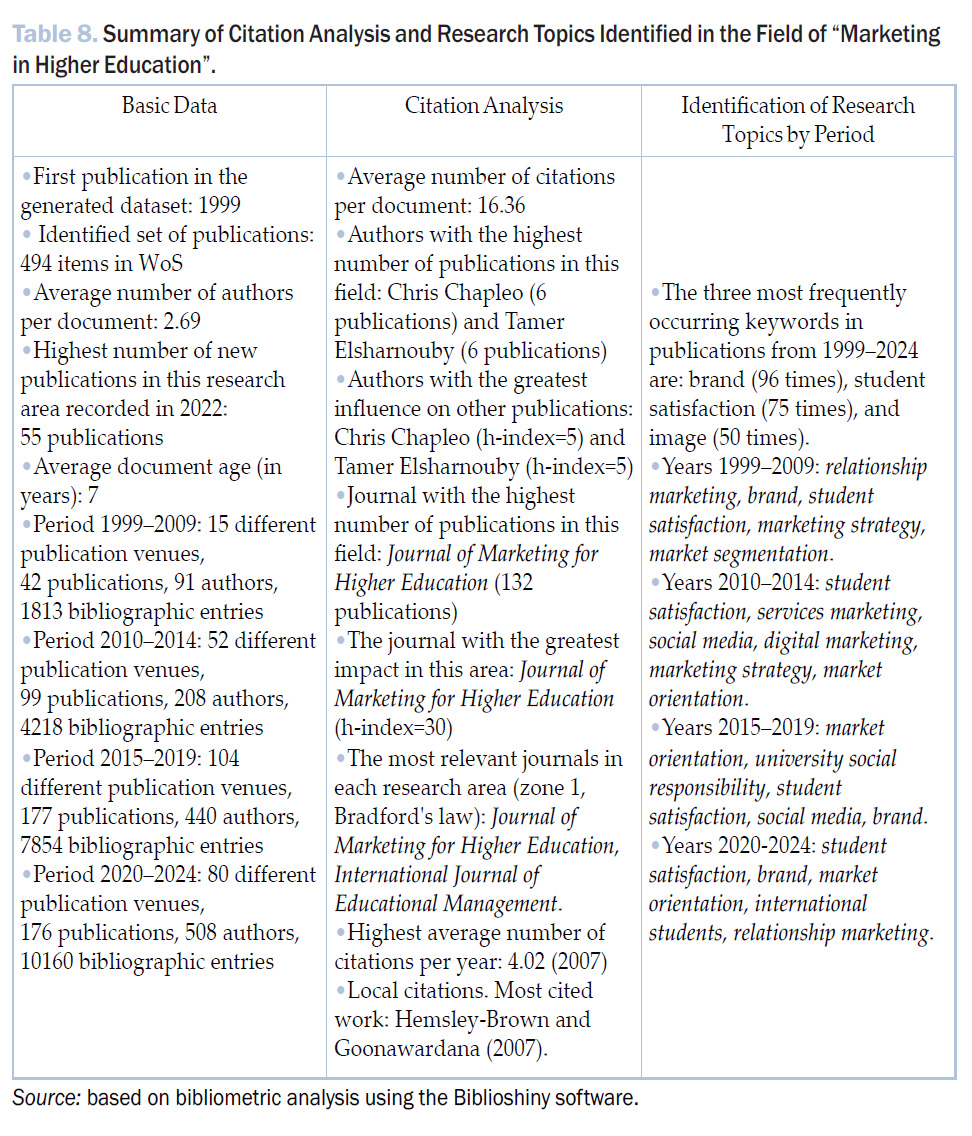
The thematic relevance of research topics varies across periods. While student satisfaction remains a core theme, brand-related research has fluctuated in prominence. These findings highlight the evolving priorities in marketing research within higher education.
Overall, the findings of this study provide a comprehensive overview of how marketing research in higher education has evolved, highlighting key publications, influential authors, and dominant research themes. The results suggest that while the field continues to grow, its expansion is steady rather than rapid, with knowledge transfer largely influenced by broader marketing research. As competition among universities increases, branding, student satisfaction, and digital marketing are likely to remain key focal points in future research.
References
Amado Mateus, M., & Juarez Acosta, F. (2022, June). Reputation in higher education: a systematic review. Frontiers in Education, 7, 925117.
Anderson, M. H. (2006). How can we know what we think until we see what we said? A citation and citation context analysis of Karl Weick’s the social psychology of organizing. Organization Studies, 27(11), 1675–1692.
Aria, M., & Cuccurullo, C. (2017). bibliometrix: An R-tool for comprehensive science mapping analysis. Journal of Informetrics, 11(4), 959–975.
Bar-Ilan, J. (2010). Citations to the ‘‘introduction to informetrics’’ indexed by WoS, Scopus and Google Scholar. Scientometrics, 82(3), 495–506. https://doi.org/10.1007/s11192-010-0185-9
Bennett, R., & Ali-Choudhury, R. (2009). Prospective students’ perceptions of university brands: An empirical study. Journal of Marketing for Higher Education, 19(1), 85–107. https://doi.org/10.1080/08841240902905445
Börner, K., Chen, C., & Boyack, K. W. (2003). Visualizing knowledge domains. Annual Review of Information Science and Technology, 37(1), 179-255. https://doi.org/10.1002/aris.1440370106
Brown, R., & Carasso, H. (2013). Everything for sale? The marketisation of UK higher education. Routledge.
Cartes-Velásquez, R., & Manterola Delgado, C. (2014). Bibliometric analysis of articles published in ISI dental journals, 2007–2011. Scientometrics, 98, 2223–2233.
Clark, M., Fine, M. B., & Scheuer, C. L. (2017). Relationship quality in higher education marketing: the role of social media engagement. Journal of Marketing for Higher Education, 27(1), 40–58. https://doi.org/10.1080/08841241.2016.1269036
Cobo, M. J., Chiclana, F., Collop, A., de Ona, J., & Herrera-Viedma, E. (2013). A bibliometric analysis of the intelligent transportation systems research based on science mapping. IEEE Transactions on Intelligent Transportation Systems, 15(2), 901–908. https://doi.org/10.1109/TITS.2013.2284756
Cobo, M. J., López-Herrera, A. G., Herrera-Viedma, E., & Herrera, F. (2011b). An approach for detecting, quantifying, and visualizing the evolution of a research field: A practical application to the Fuzzy Sets Theory field. Journal of Informetrics, 5(1), 146–166. https://doi.org/10.1016/j.joi.2010.10.002
Cobo, M. J., López‐Herrera, A. G., Herrera‐Viedma, E., & Herrera, F. (2011a). Science mapping software tools: Review, analysis, and cooperative study among tools. Journal of the American Society for Information Science and Technology, 62(7), 1382–1402. https://doi.org/10.1002/asi.21525
Constantinides, E., & Zinck Stagno, M. C. (2011). Potential of the social media as instruments of higher education marketing: A segmentation study. Journal of Marketing for Higher Education, 21(1), 7–24. https://doi.org/10.1080/08841241.2011.569589
Drapińska, A. (2011). Zarządzanie relacjami na rynku usług edukacyjnych szkół wyższych [Relationship management in the market of educational services in higher education]. Wydawnictwo Naukowe PWN.
Dwyer, T. (2024). Conceptualisations of market orientation in the higher education literature. Journal of Marketing for Higher Education, 34(2), 828–850.
Dziewanowska, K. (2018). Współtworzenie wartości w marketingu: Przykład szkolnictwa wyższego. [Co-creating value in marketing: The case of higher education]. Wydawnictwo CH Beck.
Ejdys, J. (2016). Problematyka społecznej odpowiedzialności biznesu jako obiekt naukowych zainteresowań—wyniki analizy bibliometrycznej [The issue of corporate social responsibility as a subject of scientific interest—Results of a bibliometric analysis]. Przegląd Organizacji, 4, 36–44.
Falagas, M. E., Pitsouni, E. I., Malietzis, G. A., & Pappas, G. (2008). Comparison of PubMed, Scopus, Web of Science, and Google Scholar: Strengths and Weaknesses. FASEB Journal, 22(2), 338–342. https://doi.org/10.1096/fj.07-9492LSF
Faraoni, N., Luque-Martínez, T., & Doña-Toledo, L. (2023). A bibliometric analysis to reveal the drivers of university reputation. Journal of Marketing for Higher Education, 1–25. https://doi.org/10.1080/08841241.2023.2242804
Fauzi, M. A., Wahab, N. A., Ahmad, M. H., & Abidin, I. (2023). University social responsibility: The present and future trends based on bibliometric analysis. Journal of Applied Research in Higher Education, 16(3), 948–965. https://doi.org/10.1108/JARHE-03-2023-0110
Gao-Yong, L., Ji-Ming, H., & Hui-Ling, W. (2012). A co-word analysis of digital library field in China. Scientometrics, 91(1), 203–217. https://doi.org/10.1007/s11192-011-0586-4
Hall, H. (2011). Marketing w szkolnictwie [Marketing in education]. Wolters Kluwer Polska.
Hall, H. (2022). Satysfakcja studenta. Pomiar, modele, implikacje [Student satisfaction: Measurement, models, implications]. Oficyna Wydawnicza Politechniki Rzeszowskiej.
Helgesen, Ø. (2008). Marketing for higher education: A relationship marketing approach. Journal of Marketing for Higher Education, 18(1), 50–78. https://doi.org/10.1080/08841240802100188
Hemsley-Brown, J., & Goonawardana, S. (2007). Brand harmonization in the international higher education market. Journal of Business Research, 60(9), 942–948. https://doi.org/10.1016/j.jbusres.2007.01.019
Hemsley‐Brown, J., & Oplatka, I. (2006). Universities in a competitive global marketplace: A systematic review of the literature on higher education marketing. International Journal of public sector management, 19(4), 316–338. https://doi.org/10.1108/09513550610669176
Hoang, A. D. (2023). A bibliometrics analysis of research on teachers’ satisfaction from 1956 to 2022. International Journal of Educational Management, 37(1), 164–185. https://doi.org/10.1108/IJEM-01-2022-0009
Huang, M. H., & Chang, C. P. (2016). A comparative study on three citation windows for detecting research fronts. Scientometrics, 109(3), 1835–1853. https://doi.org/10.1007/s11192-016-2133-9
Ikram, M., & Kenayathulla, H. B. (2022). A systematic literature review of student satisfaction: What is next. International Journal of Advanced Research in Education and Society, 4(4), 50–75.
Jain, R., & Rao, M. (2024). A Bibliometric Analysis of the Impact of Digital Marketing in Higher Education. The International Journal of Interdisciplinary Organizational Studies, 19(1), 123. https://doi.org/10.18848/2324-7649/CGP/v19i01/123-148
Karakose, T., Tülübaş, T., Papadakis, S., & Yirci, R. (2023). Evaluating the intellectual structure of the knowledge base on transformational school leadership: a bibliometric and science mapping analysis. Education Sciences, 13(7), 708. https://doi.org/10.3390/educsci13070708
Kirp, D. L. (2003). Shakespeare, Einstein, and the bottom line: The marketing of higher education. Harvard University Press.
Le, Q. H., Fuller, R., Hoang, T. H., & Nguyen, N. (2023). Branding in higher education: a bibliometric analysis and research agenda. Journal of Marketing for Higher Education, 1–24. https://doi.org/10.1080/08841241.2023.2289020
Leja, K. (2011). Koncepcje zarządzania współczesnym uniwersytetem [Concepts of management in the modern University]. Wydawnictwo Politechniki Gdańskiej.
Lowrie, A. (2007). Branding higher education: Equivalence and difference in developing identity. Journal of Business Research, 60(9), 990–999. https://doi.org/10.1016/j.jbusres.2007.01.024
Maringe, F., & Gibbs, P. (2008). Marketing higher education: Theory and practice. McGraw-Hill Education (UK).
Moher, D., Liberati, A., Tetzlaff, J., Altman, D. G., & the PRISMA Group. (2009). Preferred reporting items for systematic reviews and meta-analysis: The PRISMA statement. Annals of Internal Medicine, 151(4), 264–269. https://doi.org/10.1371/journal.pmed.1000097
Molesworth, M., Scullion, R., & Nixon, E. (Eds.). (2011). The marketisation of higher education and the student as consumer. Routledge.
Mourad, M., Ennew, C., & Kortam, W. (2011). Brand equity in higher education. Marketing Intelligence & Planning, 29(4), 403–420. https://doi.org/10.1108/02634501111138563
Noyons, E. C. M., Moed, H. F., & Luwel, M. (1999). Combining mapping and citation analysis for evaluative bibliometric purposes: A bibliometric study. Journal of the American Society for Information Science, 50(2), 115–131. https://doi.org/10.1002/(SICI)1097-4571(1999)50:2<115::AID-ASI3>3.0.CO;2-J
Onditi, E. O., & Wechuli, T. W. (2017). Service quality and student satisfaction in higher education institutions: A review of literature. International Journal of Scientific and Research Publications, 7(7), 328–335.
Oplatka, I., & Hemsley-Brown, J. (2021). A systematic and updated review of the literature on higher education marketing 2005–2019. In H. J. Bidgoli (Ed.), Handbook of operations research and management science in higher education (pp. 35–80).
Paswan, A. K., & Ganesh, G. (2009). Higher education institutions: Satisfaction and loyalty among international students. Journal of Marketing for Higher Education, 19(1), 65–84. https://doi.org/10.1080/08841240902904869
Pawar, S. K. (2024). Social media in higher education marketing: a systematic literature review and research agenda. Cogent Business & Management, 11(1). https://doi.org/10.1080/23311975.2024.2423059
Peruta, A., & Shields, A. B. (2017). Social media in higher education: understanding how colleges and universities use Facebook. Journal of Marketing for Higher Education, 27(1), 131–143. https://doi.org/10.1080/08841241.2016.1212451
Rabenu, E., & Shkoler, O. (2022). A systematic and theoretical approach to the marketing of higher education. Frontiers in Psychology, 13. https://doi.org/10.3389/fpsyg.2022.982347
Rauschnabel, P. A., Krey, N., Babin, B. J., & Ivens, B. S. (2016). Brand management in higher education: the university brand personality scale. Journal of Business Research, 69(8), 3077–3086. https://doi.org/10.1016/j.jbusres.2016.01.023
Santini, F. de O., Ladeira, W. J., Sampaio, C. H., & da Silva Costa, G. (2017). Student satisfaction in higher education: a meta-analytic study. Journal of Marketing for Higher Education, 27(1), 1–18. https://doi.org/10.1080/08841241.2017.1311980
Sun, Z., & Lim, M. A. (2023). A systematic literature review of higher education reputation management: Active/reactive framework. International Journal of Chinese Education, 12(2). https://doi.org/10.1177/2212585X23117
Van Raan, A. (2019). Measuring science: basic principles and application of advanced bibliometrics. In W. Glänzel, H. F. Moed, U. Schmoch, & M. Thelwall (Eds.) Springer handbook of science and technology indicators (pp. 237–280).
Weerasinghe, I. S., & Fernando, R. L. (2017). Students’ satisfaction in higher education. American Journal of Educational Research, 5(5), 533–539. Available at SSRN: https://ssrn.com/abstract=2976013
Yaping, X., Huong, N. T. T., Nam, N. H., Quyet, P. D., Khanh, C. T., & Anh, D. T. H. (2023). University brand: A systematic literature review. Heliyon, 9(6). https://doi.org/10.1016/j.heliyon.2023.e16825
Zupic, I., Cater, T. (2015). Bibliometric methods in management and organization. Organizational Research Methods, 18(3), 429–472. https://doi.org/10.1177/1094428114562629
1 Citation analysis measures the number of citations a paper has received, so that an overall assessment of the quality of the paper can be made (Andreson, 2006). This approach is based on the premise that frequently cited articles are considered influential within their research field. The underlying assumption is that authors cite papers that they consider important to their own work (Zupic & Cater, 2015). Citations also reflect the degree of knowledge transfer and dissemination, indicating how widely a paper is recognized and referenced by researchers from other institutions and research centres (Ejdys, 2016).
2 Dividing research data into periods is a key step in the analysis of thematic evolution (Cobo et al., 2011b). This segmentation serves two purposes: (1) preventing data homogeneity and (2) enabling the identification of research field developments over time (Karakose et al., 2023). Ou dataset was divided into four periods based on two key considerations. The first is the standard timeframe for research in identifying research trends, which is typically five years (Huang & Chang, 2016). Second, graph analyses of annual publication trends revealed that research in this field initially experienced low but steadily increasing publication rates. Therefore, to obtain enough data to be subjected to thematic evolution analysis, we decided to extend the first-time interval. The resulting intervals are characterised by enough publications so that the number of author keywords obtained on this basis can be subjected to analysis.
3 The spikes in citations for these years are likely attributable in part to the appearance of two of the most cited publications in the collection: Hemsley-Brown & Goonawardana (2007) and Bennett & Ali-Choudhury (2009). According to Google Scholar, these articles have been cited 576 and 387 times, respectively (as of 03.11.2024).
4 To refine the authoritative keyword dataset, we excluded certain terms from the analysis, such as keywords already used as search criteria, country names, and other non-thematic terms. Additionally, we standardized terminology by replacing plural keywords with singular forms, expanding acronyms into full names, and merging similar expressions to ensure consistency. This process helped create a more structured and accurate identification of research themes in marketing in higher education while reducing redundancy in the dataset.
5 The thematic maps are constructed using two axes: the x-axis represents the relevance of the theme, while the y-axis reflects its level of development. Themes are depicted as ovals (bubbles), each representing a network cluster labeled with the most frequently occurring keyword in that cluster. The size of each bubble corresponds to the number of occurrences of the keywords within the cluster, and its position on the map is determined by its relevance and stage of development. To ensure clarity, the analysis was limited to 75 keywords, meaning that only the most frequently occurring research topics are displayed on the maps.


